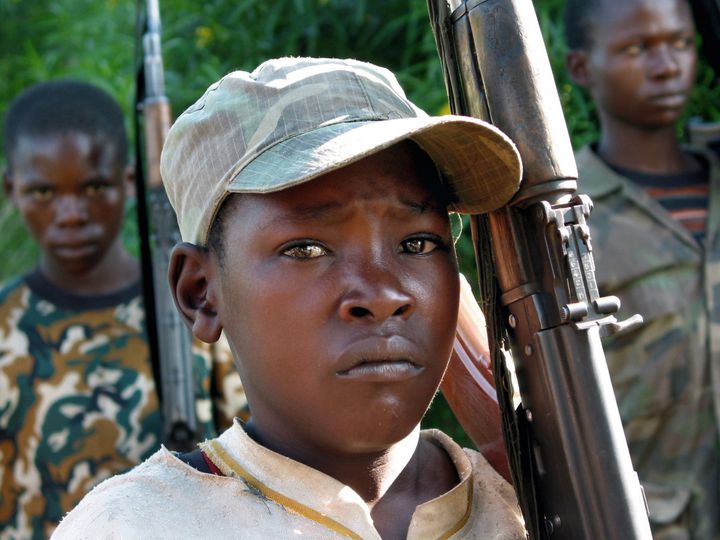
Many of the children fighting in the Democratic Republic of Congo’s militia groups were abducted and forced to enlist. But researchers have found that girls are joining the groups voluntarily, motivated by a lack of access to education and a future with no prospects.
Throughout the decades-long conflict in the Democratic Republic of Congo (DRC), children have been abducted and made to serve as soldiers. While most are male, it is estimated over a third are female, used mainly as domestic and sexual servants, but sometimes as fighters. Now the London-based NGO Child Soldiers International (CSI) has released a report showing that many of the girls in armed groups weren’t enlisted by force. They joined of their own free will – driven by poverty and a lack of access to education.
The NGO interviewed over 200 female former child soldiers following their escape from local militia groups, collectively known as the Mai Mai. The researchers found that many of the girls who had joined by choice cited the burden of school fees as their primary reason. Education was beyond their reach, but life with an armed group would at least offer them food, security and, they thought, better opportunities. “I was pushed out of school for failing to pay the fees, so instead of roaming aimlessly in town, it was better to go and help [the militia] in the bush,” one girl was quoted as saying in CSI’s report.
“Sometimes they join the Mai Mai encouraged by their parents, who think that providing their children to the armed group can protect the family against attacks and looting,” says Sandra Olsson, spokeswoman for CSI. “Although it may sound like a choice, in reality it could be their only option to escape a life of utter poverty or to protect themselves from constant and terrifying attacks on their villages.”
But for all the girls who join, whether voluntarily or by force, the reality is that life under the control of armed groups is one of servitude and abuse. As one of the girls interviewed by CSI put it: “Life in the bush was only suffering.”
The girls said they were used as domestic servants and sex slaves. Many were repeatedly raped, often by different men, and drugged. “I would wake up and find myself naked,” one victim told the researcher. “They gave us drugs so that we would not get tired of all of them using us.”
The girls also described how they were forced to loot goods and then carry the heavy spoils through the bush, for hours and sometimes days. Those who were too weak to carry their pillaged load were killed.
But for many of the girls, escape offered little relief. When they finally make it back home, girls who have been living with the Mai Mai are “often stigmatized and rejected by the community and also experience difficulties in rehabilitation,” says Dede Nkuluba, spokeswoman for Reconfort, a local organization that helps reintegrate former child soldiers.
The assumption that all female child soldiers are used for sex leads to many of them becoming isolated and, as a result, living in poverty. “For the majority of girls we interviewed, we were struck to find out that a major source of distress came from the current stigmatization, if not outright rejection, they faced when they finally returned home, because [in their words], they had ‘known men in the bush,’” says the CSI’s Olsson.
“Some of the girls we talked to even said that they had considered going back because they couldn’t take the pain of being stigmatized and excluded from community life,” she says. Furthermore, advocates believe this stigma could explain why many girls choose to stay in the militias and suffer.
Though it’s difficult to get accurate figures for the number of girls within the Mai Mai, the United Nations Organization Stabilization Mission in the Democratic Republic of the Congo (MONUSCO)estimates that girls make up around 30 to 40 percent of children in armed groups. Between January 2009 and November 2015, out of 8,546 former child soldiers registered by MONUSCO, only 7 percent were girls. That leaves a disproportionately high number of girls either unaccounted for or still serving as members of the armed groups.
The former female child soldiers who spoke to CSI researchers said, that when they escaped, they left many girls behind. As well as fearing rejection by their communities, girls within the groups are often subjected to stricter security measures than boys. And during demobilization, girls aren’t considered soldiers but “wives” and, in some cases, mothers, so they are often held back, or hidden away, when militia commanders hand over the children in their ranks to child-protection agencies.
Despite their ordeals, many of the girls interviewed by CSI still hold on to dreams of a better life. According to Nkuluba of Reconfort, many female child soldiers find it difficult to re-enter the school system because they are usually too old by the time they manage to escape. But the girls in the CSI study said they were determined to get an education in the hope that it would lead to a positive identity and acceptance by their communities.
One recurring theme in the CSI’s research is the importance of access to education for girls, both in helping those who are trying to reintegrate and for preventing them from joining the Mai Mai in the first place.
“Prevention is rarely prioritized in a situation of ongoing conflict,” says Olsson. “We need long-term interventions to stabilize and pacify communities. Education is an important part of that.”
This article originally appeared on Women & Girls Hub. For weekly updates, you can sign up to the Women & Girls Hub email list.